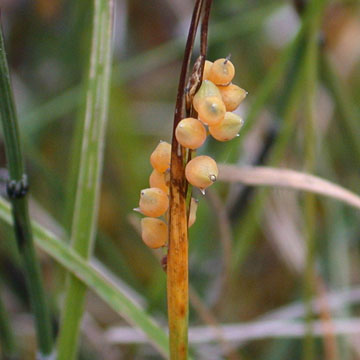

Carex aurea - (image 1 of 5)
Taxonomy
Family: Cyperaceae
Section Bicolores (formerly in Paniceae)
Habitat
Moist, open or shaded habitats including meadows, seeps, and fens, usually in calcareous areas.
Associates
Distribution
Newfoundland to AK, south to PA, northern IN, MN, NE, NM, and CA.
Morphology
Herbaceous perennial; stems slender, 3-40 cm, solitary or in small tufts on long creeping rhizomes; leaves mostly 1-4 mm wide, often surpassing the stems; spikes 2-several, 5-20 mm, approximate or more or less remote; middle internodes 0.5-1.5 mm; terminal spike usually staminate, 0.9-2 mm wide; proximal staminate scales 2-3.5(-4) mm; perigynia bright orange when mature, divergent, ellipsoid or more often obovoid or obovoid-globose, beakless, usually little if at all compressed, 1.7-3 mm, 12-20-ribbed to nearly nerveless; pistillate scales half to fully as long as the perigynia, divergent in mature fruit; stigmas usually 2, the achene lenticular and often plump, occasionally trigonous if flowers with 3 stigmas.
Notes
Fruiting June to July
Wetland indicator: FACW
The name refers to the unique color of the ripe perigynia, which are often fleshy and edible.
Carex garberi Fern. is similar, the main difference being the perigynia which are papillose and maturing to glaucous-white rather than golden-orange. It also tends to have the perigynia more densely arranged in the spikes and the terminal spike often gynecandrous rather than entirely staminate. The plant in the last image appears to have these characteristics, however it was photographed in mid-May and the two species tend to look very much alike if the perigynia are not mature.
References
Gleason, Henry A. and A. Cronquist. 1991. Manual of Vascular Plants of
Northeastern United States and Adjacent Canada. Second Ed.
The New York Botanical Garden. Bronx, NY
|
© Michael Hough 2018 |